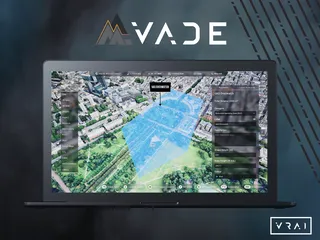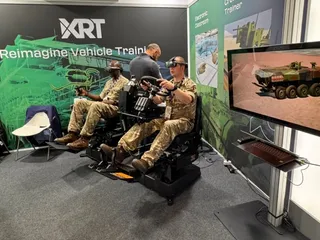Predictive Tools in Aviation Training
Contact Our Team
For more information about how Halldale can add value to your marketing and promotional campaigns or to discuss event exhibitor and sponsorship opportunities, contact our team to find out more
The Americas -
holly.foster@halldale.com
Rest of World -
jeremy@halldale.com
.jpg/r%5Bwidth%5D=320/815e4b30-7768-11f0-a867-8daedd67e058-CAT-MP-Predictive-Tools-feature-dangerous-goods-crew-member-taking-readings%20(1).webp)
The aviation industry stands at the threshold of a technological change that promises to transform how pilots and aviation professionals are trained and assessed. Artificial intelligence (AI) is revealing its potential of analyzing large datasets, identifying patterns, and providing insights into training effectiveness and competency development.
This transformation extends beyond the automation or digitization of existing processes. AI can introduce entirely new dimensions of data analysis, from biometric sensors and eye-tracking technology to sophisticated natural language processing of instructor feedback.
These capabilities can enable a shift toward more personalized, evidence-based training methodologies that can adapt to individual learning patterns and provide real-time performance insights.
However, the integration of AI into aviation training requires a fundamental rethinking of traditional training paradigms. The industry must navigate the tension between time-tested manual evaluation methods and data-driven approaches, while addressing legitimate concerns about the reliability and safety implications of AI-assisted decision-making in critical training contexts.
As competency-based training and assessment (CBTA) gains momentum across various aviation sectors beyond pilot training, the challenge lies not just in developing sophisticated AI tools, but in creating frameworks for their implementation within the highly regulated and safety-critical aviation environment.
Current vs AI-based Use of Data
Cedric Paillard, chief executive officer (CEO) of the Airline Pilot Club, points out that what makes AI particularly interesting today is the emergence of new types of data and the ability to combine these sources in a meaningful way. “This integration can significantly support instructors, airline or flight school training managers and decision makers in general, helping them to make the right decisions at the right time and more efficiently. For example, the ability to interpret an instructor’s written feedback and generate analytics based on it is proving to be extremely valuable, especially in the context of evidence-based training (EBT). “This represents a real step forward,” he says.
When organizations begin to see the feedback loop in action and realise what AI can do with well-organized and structured data, and when AI integrates that data correctly into the training system, they begin to understand how crucial it is to organize data effectively, Paillard observes. “If an instructor does not comment on a very specific question during a flight simulation, AI will not be able to predict what the instructor would say. Data must be available in a formalized format, and the more accessible that data is, the greater the value of AI. There has certainly been a wake-up call in the industry about how to organize data and ensure its accessibility.”
Current Limitations
Concerning the type of data that is available for use, Colin Hillier, a former Royal Navy officer and CEO of Mission Decisions, affirms that there exist shareable datasets and powerful models, such as those from the Met Office or OpenStreetMap. “There are many excellent examples of shared datasets, but, during training, much of the data is not indexed in a way that makes it useful for sharing or even just general use,” he says.
While AI tools offer impressive capabilities, such as generating creative content or assisting with basic learning, according to Hillier AI tools still have significant limitations when applied in serious, safety-critical contexts. “The challenge is to apply these tools reliably and in a controlled manner. Some of the work we are doing to automate training analysis and design is crucial. Training analysis, which includes designing and creating training courses, has until now been largely a manual process. But with the new generation of AI tools, just as the industrial revolution paved the way for mass production, we can now automate document processing on a scale previously impossible,” he says. “For example, we can take a source document and automatically transform it into a training course. While humans can do this, AI can dramatically speed up the process. If AI fails to do something correctly, it flags the error, so it does not replace humans, but rather assists them more efficiently. True transformation will come from automating tedious tasks we have always tried to avoid.”
The aviation training industry has access to a significant wealth of data, but to develop meaningful insights from it, it is necessary to first know which data is relevant, affirms Margareta de Freitas, innovation lead at Thales. “This means asking the right questions upfront. Exploring a sea of data that was not collected for a specific purpose can be very difficult. It is much more effective to know exactly what questions one is asking and what information one is looking for,” she says. “This way, one can focus on collecting the data that will truly be useful in the context. This approach is very different from collecting everything indiscriminately. Understanding what data is needed and where to find it is crucial.”
Behavioral Focus
Marty Kauchak, group editor at Halldale and a retired US Navy captain, observes that AI is accelerating CBTA. “It is been interesting to observe over the past four to six months how CBT is being discussed not only in the context of pilot training but increasingly in adjacent civil aviation sectors as well,” he says. “There is a growing focus on CBTA, and the integration of AI, in training programs for maintenance workers, baggage handlers, those handling dangerous goods – and others. Thus, there is growing interest in extending both the use of AI and competency-based training to these adjacent civil aviation training programs. It is fascinating how, with the shift to competency-based learning, these skills, once dismissed as ‘soft skills,’ are becoming increasingly important.”
In this context, AI is a tool that, correctly applied, can bring transparency. “It allows us to examine real events and connect them to observed behaviors, essentially, it helps make the process more human. For example, using a large language model (LLM), one can interrogate the system, asking natural, intuitive questions. This is important because, historically, AI systems have often been ‘black boxes’ generating output, but without users really understanding how or why”, de Freitas says. “What is promising about AI today, is that in well-defined contexts it can open that black box. It then offers a way to see into the system’s reasoning and connect it to human-relevant observations. And this is crucial when dealing with something as complex and nuanced as expertise.”
It is important to remember that AI is ultimately there to support humans, according to de Freitas. “Whatever task we are tackling,
we must remember that AI is meant to be at our service. Keeping humans at the center is crucial,” she says. “An LLM is part of a broader mix of technologies. It cannot be used in isolation, it simply would not work. On its own, it could generate irrelevant or even meaningless output. That is why it is necessary to provide context. It needs to be integrated into a hybrid AI system, combining it with other techniques and systems. This is what will make it truly effective. It is about choosing the type of data that will truly help both the user and the AI provide meaningful and accurate answers. In a hybrid AI system, multiple components work together, and it is essential for the AI to understand the context in which it should generate a response. This context comes from relevant, well-curated data.”
Biometric Focus
According to de Freitas, the data that is used in training, especially when pilots are involved, should be as minimally invasive as possible. “In our current projects, we are looking at events, action chains and observed behaviors. We do not use heart rate or other similar physiological characteristics, because we believe that they are not needed at this stage for the first level of tools that could be used,” she says. “That said, this data could of course be used later to refine the tools or make them more powerful than they are today. But in general, we focus on observed behaviors, what happens in the cockpit or, in fact, in the simulator.”
AI Governance
In civil aviation, there are clear guidelines and recommendations on how to manage the transition towards CBTA or evidence-based training (EBT), observes de Freitas. “The use of AI or data analytics is not necessarily included yet, or at least not fully integrated. There are guidelines on how AI can be used,” she says. “However, a ‘tool-based’ approach, whereby there is data and real-time analysis is perform, is different and not yet fully integrated into the regulatory framework.”
Kauchak observes that the European Union Aviation Safety Agency (EASA) is a bit ahead of its counterparts when it comes to AI collaboration. “EASA published its AI roadmap back in February 2020. The FAA is catching up, but it is important to note that the FAA’s latest roadmap shows its interest in collaborating with EASA, not only in terms of research and development, but also in policy,” he says. “So, this is a work in progress and something we will need to continue monitoring.”
Summing Up
The integration of AI into aviation training represents a paradigm shift that promises to enhance both the effectiveness and efficiency of how aviation professionals develop critical competencies. From predictive maintenance analytics to personalised learning pathways and advanced biometric analysis, AI is opening new frontiers in understanding and optimising human performance in aviation.
The journey toward widespread AI adoption in aviation training is marked by both remarkable potential and significant challenges. While younger generations of pilots and instructors are more open to embrace data-driven approaches, the industry must thoughtfully manage the cultural transition from traditional evaluation methods to AI-enhanced systems. The success of this transformation depends on maintaining human expertise at the center within hybrid AI systems that are more transparent.
The effectiveness of these systems ultimately depends on the quality and structure of the underlying data, a realisation that requires the industry to move towards more systematic approaches to data collection and organisation. The collaborative approach between international aviation authorities suggests recognition that AI integration requires coordinated global standards rather than fragmented national approaches.
Looking ahead, the most successful implementations of AI in aviation training will likely be those that maintain a clear focus on competency-based outcomes while leveraging AI’s unique strengths in pattern recognition, data analysis, and personalised instruction.


